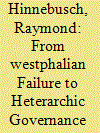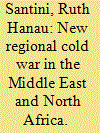| Srl | Item |
| 1 |
ID:
159359


|
|
|
|
|
| Summary/Abstract |
The problematic export of the Westphalian system to MENA is examined, taking Syria as exemplar. The export model is juxtaposed to actual non-lineal trajectories, semi-sovereignty and hybrid or failing states. This is manifested in post-uprising Syria in failing statehood, fragmented and overlapping governance, permeable and collapsing borders, the loss of sovereignty to trans-state movements, “competitive regime-building” between the Asad regime and jihadist warlords, and “competitive interventionism” by external powers filling the governance vacuum with their own proxies. The result is heterarchic zones of limited statehood in which state sovereignty is contested by both international (supra-state) penetration and sub-state fragmentation.
|
|
|
|
|
|
|
|
|
|
|
|
|
|
|
|
| 2 |
ID:
157503


|
|
|
|
|
| Summary/Abstract |
Since the 2003 Iraq war, the Middle East and North Africa has entered into a New Regional Cold War, characterised by two competing logics: on the one hand, the politicisation of sectarianism opposing a Saudi-led Sunni bloc against an Iran-led Shia bloc and, on the other, an intra-Sunni cleavage around the mobilisation of political Islam, embodied by the Muslim Brotherhood and its supporters vs its opponents. Blending Buzan and Weaver’s regional security complex theory with Donnelly’s notion of ‘heterarchy’ and applying it to the cold wars the region has experienced, the similarities and differences between the Arab Cold War of the 1950s/60s and the New Regional Cold War reveal the increasing number of heterarchic features within the regional security complex: multiple and heterogeneous power centres, different power rankings, a more visible and relevant role of non-state and transnational actors, and the fragmentation of regional norms.
|
|
|
|
|
|
|
|
|
|
|
|
|
|
|
|